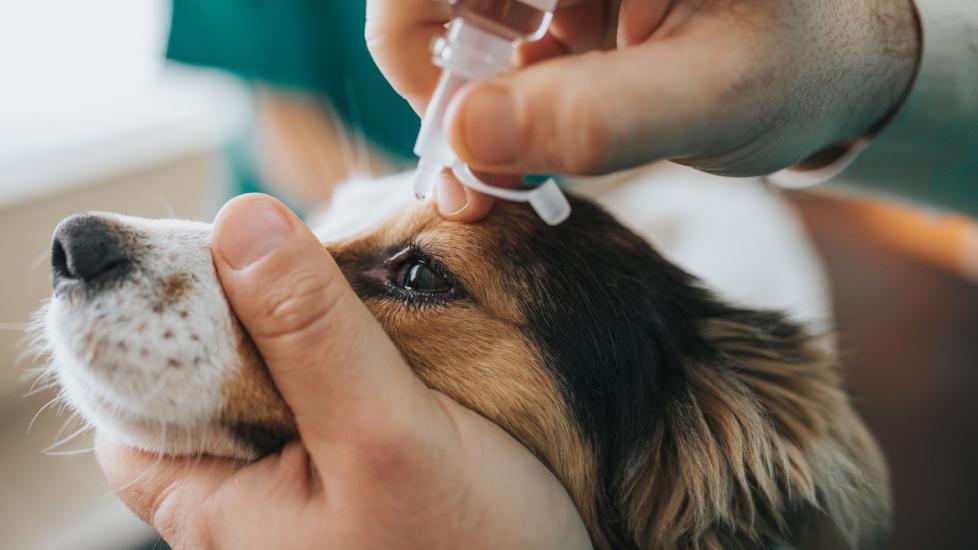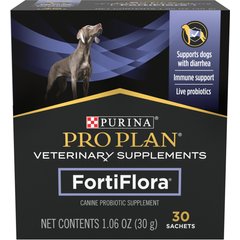Conjunctivitis in Dogs (Pink Eye)
What is Conjunctivitis in Dogs?
Conjunctivitis, also called pink eye, is a common condition in dogs (just like it is in humans). The term conjunctivitis means inflammation (swelling) of the conjunctiva, which is the tissue covering the eyeball and eyelids. This tissue is a mucous membrane, which is a layer of cells that make mucus.
Dogs have a nictitating membrane (often called a third eyelid), which is located at the inner corner of each eye and is made of conjunctiva. Normal, healthy conjunctiva is usually pink in color, though it can be pigmented in some dog breeds. When inflammation of this tissue (conjunctivitis) occurs, the mucous membranes swell, become itchy, and turn brighter pink or red.
Types of conjunctivitis include:
Allergic Conjunctivitis
Any breed of dog may develop allergic conjunctivitis, but it’s especially common in any dog predisposed to atopic dermatitis (hypersensitivity to a variety of common substances in the environment). This occurs most often in young adults, but it can occur at any age. Frequent contributors include environmental allergens, such as dust, pollen, molds, mites, perfumes, and shampoos; food allergens (usually certain proteins); and atopy (a genetic tendency to develop allergies).
Viral Conjunctivitis
Any breed of dog may develop viral conjunctivitis if they encounter viruses that cause inflammation in the eye membranes. These viruses are usually quite contagious and can take 3 to 4 weeks to fully resolve. Examples of viruses that can cause these signs in dogs include canine distemper virus and canine herpesvirus.
Bacterial Conjunctivitis
Primary bacterial conjunctivitis is uncommon in dogs, and there are no known age, gender, or breed predispositions for it. More commonly, secondary bacterial infections occur in the eyes because of underlying medical issues. These medical conditions include chronic dry eye, eyelid abnormalities, and corneal ulceration (scrapes to the outer layer). The most common types of bacteria that cause conjunctivitis are Staphylococcus or Streptococcus, which are both very contagious for dogs.
Other medical conditions that can make a dog more prone to conjunctivitis include:
-
Immune-mediated conditions
-
Tumors of the eyelid or conjunctiva
-
Keratoconjunctivitis sicca (dry eye)
-
Eyelid abnormalities such as entropion (rolling in of the lower eyelid), ectropion (rolling out of the lower eyelid), or abnormal eyelash growth
-
Blocked tear ducts
-
Trauma to the eye from smoke, foreign objects, or pollutants
-
Glaucoma (high pressure in the eye)
-
Uveitis (low pressure in the eye from inflammation)
-
Breed-associated conditions such as nodular episcleritis in Collies
-
Parasites (uncommon)
Vet Recommended Health Support
- Purina Pro Plan Veterinary Diets FortiFlora Powder Probiotic Digestive Supplement for Dogs, 30 count$30.99Chewy Price
- VetClassics Pet-A-Lyte Oral Electrolyte Solution Dog & Cat Supplement, 32-oz bottle$17.99Chewy Price
- Nutramax Welactin Omega-3 Liquid Skin & Coat Supplement for Dogs, 16-fl oz$27.99Chewy Price
- Fera Pets USDA Organic Pumpkin Plus Fiber Support for Dogs & Cats, 90 servings$34.95Chewy Price
Symptoms of Conjunctivitis in Dogs
When your dog has pink eye, the membranes of the eye become red and swollen. Often, they are itching, burning, or painful, causing dogs to rub their faces on rugs or with their paws. Squinting or excessive blinking is often noted because of discomfort in the eye. Normally, there is a cloudy white, yellow, or green tinged mucus-like discharge from the affected eye(s). Green/yellow discharge is usually associated with bacterial infection while clear or white discharge is more likely to be caused by allergies. Usually both eyes are affected or will become affected unless the inflammation is secondary to trauma, eyelid abnormalities, blocked tear ducts, or tumors.
Other clinical signs such as generalized itching, hair loss around the eyes, nasal discharge, sneezing, coughing, and lethargy may also occur.
Causes of Conjunctivitis in Dogs
The cause of conjunctivitis can be allergic, viral, bacterial, related to an immune system problem, related to a particular dog’s anatomy, traumatic, or cancerous. Often, the same clinical signs are the same no matter what the underlying cause. Usually, the cause requires investigation with your veterinarian through a routine exam.
How Veterinarians Diagnose Conjunctivitis in Dogs
Your veterinarian will perform a thorough physical examination as well as a thorough ophthalmic (eye) examination to look for any medical problems that may be causing the conjunctivitis. The main goal of diagnosis with conjunctivitis is to find out what’s causing it and how much damage to the eyes has occurred.
The ophthalmic examination consists of:
-
A full examination of the surrounding eye structures, including the eyelids, fur around the eye, eyelashes, third eyelid, and tear ducts.
-
Tear production testing (called Schirmer tear testing), which is a non-invasive test that checks the amount of tears produced by both eyes.
-
Corneal stain testing (called Fluorescein stain testing), which is a non-invasive test used to check the outer layer of the eye, called the cornea, for any damage such as scrapes and cuts. A yellowish stain is put in the eye, and a special light in a dark room is used to show any underlying damage.
-
Intraocular pressure testing measures the pressure in both eyes, which is helpful in diagnosing glaucoma and uveitis.
Additional testing—such as bacterial culture and sensitivity, conjunctival scraping or biopsy, allergy testing, viral testing, and ultrasound of the eyeball—and procedures like tear duct flushing are performed when needed.
Treatment of Conjunctivitis in Dogs
Treatment depends on the underlying cause of the conjunctivitis.
Allergic conjunctivitis is most commonly treated with eye drops or ointments containing steroids. Sometimes oral steroids and antihistamines are also recommended if there is systemic inflammation. Prevention is most important with allergic conjunctivitis, so you must avoid the underlying allergens affecting your dog. Allergic skin testing, flea preventatives, environmental changes, and food trials may be recommended by your veterinarian.
Bacterial conjunctivitis is often treated with topical antibiotics, though sometimes oral antibiotics and anti-inflammatory medications may also be used depending on the severity of infection. Viral conjunctivitis is often treated with time and oral antioxidants to boost the immune system, and sometimes with either oral or topical anti-viral medications.
Dogs diagnosed with eyelid or eyelash abnormalities will require surgical correction to avoid chronic issues. Dogs diagnosed with chronic dry eye will require lifelong medications to stimulate tear production. Dogs with immune-mediated medical issues will require immunomodulatory medications (those that affect the immune system) both orally and topically, often for their lifetime.
Prevention of Conjunctivitis in Dogs
In general, preventing further damage to the eye while treating the underlying issue is most important for healing. An Elizabethan collar or pet cone is helpful to avoid your dog rubbing their face or scratching their eyes, which can cause abrasions (scrapes) or even perforations (holes) in the cornea.
Frequent veterinary rechecks are often recommended to check healing and to change treatment if necessary. Your veterinarian may recommend a referral to a veterinary ophthalmologist (eye doctor) or dermatologist if clinical signs do not improve, quickly worsen, or recur and become chronic issues.
Medications for Conjunctivitis in Dogs
Medications used to treat conjunctivitis include topical gentamicin, tobramycin, oxytetracycline, ciprofloxacin, and triple-antibiotic ophthalmic ointments/drops. Some dogs will need topical and/or oral medications containing anti-inflammatories such as prednisolone or dexamethasone (both corticosteroids). Dogs diagnosed with chronic dry eye will require medications such as cyclosporine or tacrolimus to encourage tear production.
Terramycin is an over-the-counter antibacterial ophthalmic ointment that may be recommended, although it is not always the recommended or correct therapy for conjunctivitis in dogs. This is found to be helpful in many cases of feline conjunctivitis, including viral and bacterial, but it is not used as frequently for canine conjunctivitis.
Home Remedies for Conjunctivitis in Dogs
Home remedies can be used to help with discomfort and to keep the eye clean but will usually not treat the underlying medical issue. You can use sterile saline eye wash solutions gently once or twice daily to clean discharge from around your dog’s eye and to flush dust, pollens, and debris away from his eye.
Do not perform an eye flush at home without first consulting your veterinary team to ensure no further injury is made to the eye.
There are some holistic products that can be administered topically around the eye or orally to avoid tear duct blockage, which can cause conjunctivitis in some dogs. It’s important to discuss options with your veterinarian before starting any products for treating eye conditions in your dog.
Recovery and Management of Conjunctivitis in Dogs
Most dogs have an excellent prognosis when recovering from conjunctivitis. Chronic, recurrent, or severe cases may have a guarded (uncertain) prognosis depending on the cause. Many chronic or recurrent cases require lifelong therapy by controlling underlying allergies, stimulating tear production, or treating systemic or ophthalmic immune-mediated diseases. Frequent veterinary visits may be necessary to determine the best course of action and to assess response to therapy.
Conjunctivitis in Dogs FAQs
Is conjunctivitis in dogs contagious?
Conjunctivitis in dogs is often very contagious if viral or bacterial. If your dog is fully vaccinated, then viral transmission is less likely. Viral conjunctivitis is not contagious to humans. Always check with your veterinary to discuss what vaccines are recommended for your pet.
Though primary bacterial conjunctivitis is rare in dogs, it is possible to spread to humans by direct contact. It is important to wash your hands before and after touching your dog if bacterial conjunctivitis is diagnosed.
Allergic, cancerous, immune-mediated, and chronic dry eye conditions are not directly contagious to other dogs but can be if bacteria invade the eye.
Will conjunctivitis in dogs go away by itself?
Some forms of canine conjunctivitis can resolve on their own in dogs with otherwise healthy immune systems, but dogs usually require therapy to avoid chronic changes to the eyes and full resolution of the squinting, redness, pain, and discharge.
What happens if conjunctivitis in dogs is left untreated?
If left untreated, inflammation will eventually affect the outer layer of the eye, the cornea, causing scarring, chronic pain, ulceration and/or uveitis (inflammation inside the eye). Besides being painful, this can set up your dog for lifelong chronic infections.
How long does conjunctivitis in dogs last?
The duration of clinical signs depends on the underlying cause. With appropriate treatment, bacterial conjunctivitis is usually fully resolved within 5 to 7 days. Viral conjunctivitis can take up to 3 to 4 weeks for full resolution.
Allergic conjunctivitis will persist until the underlying allergen is discovered and eliminated. Chronic dry eye and immune-mediated conditions are often lifelong and require continued therapy.
Featured Image: iStock.com/skynesher




